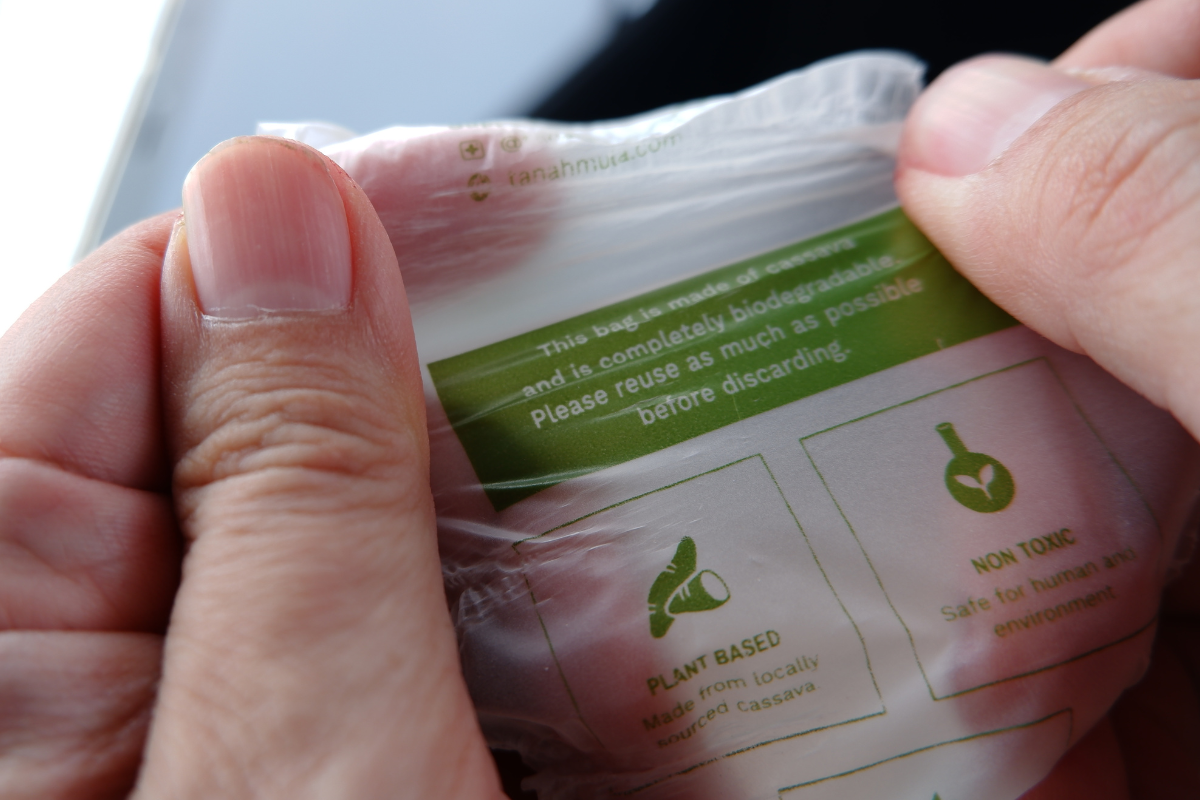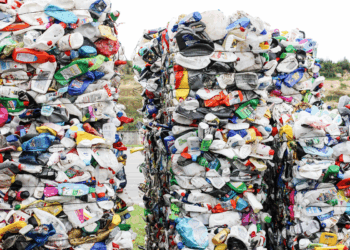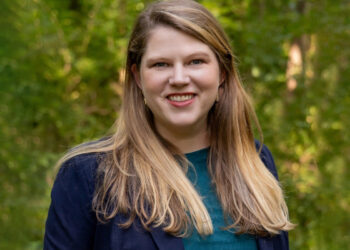This article appeared in the February 2024 issue of Resource Recycling. Subscribe today for access to all print content.
Some people might be confused as to why the Biodegradable Products Institute (BPI) is involved in petitioning the federal government to alter the definition of organic compost. Rhodes Yepsen, executive director of BPI, and Alex Truelove, the organization’s legislation and advocacy manager, said it all fits into their vision of a truly circular economy.
Yepsen and Truelove spoke with Resource Recycling about how the biodegradable and compostable packaging space is evolving and how legislation can shape it for better or for worse.
This interview has been lightly edited for length and clarity.
Talk about some of the biodegradable and compostable labels we’re seeing in the market and why they can be confusing for consumers.
Rhodes Yepsen: It’s interesting to see the variety of green claims being made on products and packaging. When you’re looking at the labels, a product could be compostable, biodegradable and plant-based—meaning they’re not mutually inclusive or exclusive. If you think about it like a Venn diagram, compostability lives inside biodegradability, whereas plant-based has an overlap with it. When we’re thinking of compostability, it’s describing the conditions and time frame in which biodegradation happens. Things can biodegrade in a variety of environments, and the microorganisms and the time frame will differ. Plant-based indicates more of the front-of-life aspect, what the item was made of, but it doesn’t necessarily indicate whether it’s going to be compostable or biodegradable. A good example of that would be something like the Coke plant bottle which has plant-based content in it but is chemically identical to fossil-based PET and can be recycled just like the conventional PET.
I think what’s confusing is that sustainability is such a broad umbrella. As we try to navigate our personal responsibilities and views around the most sustainable things we can do in our lives, there are a lot of things to think about. And it’s difficult to know when those things are aligned or not aligned. Going back to those original terms of plant-based or compostable, for instance, both of those have value in a sustainability context. Where consumers get confused is when they misattribute those claims and think that plant-based content determines how they should dispose of the product, which results in contamination at composting facilities.
That’s one of the things that we’ve been focusing on at BPI. How do we make sure that compostable products are distinguishable from conventional packaging and products? How do we make sure that the claims of compostability are clear—through the coloration and other markings—to distinguish them from other items? I think we still have a long way to go, but through our certification program, our policy work and our partnership with groups like the US Composting Council and Closed Loop Partners, a lot of progress has been made around the country.
What helps to achieve that goal? Policies or voluntary measures?
Yepsen: I think it’s a combination of both. One of the things we’ve been trying to stress with our members and our stakeholders within BPI is that we have multiple levers to pull and a complex problem like this one can’t be solved with just one function or another. We have a certification program where we can establish clear rules and pass/fail criteria. These are very objective in their assessment, which can include some labeling elements. We also have educational tools, such as consumer testing and communication pieces to guide the industry around best practices. Then there’s policy, where states can come in and require much more specific criteria than we can within a certification program. I think some intersection of all three of these things is going to move the needle. I absolutely think policy needs to be included because not everyone is going to have their products certified, and not everyone is going to follow general industry guidance—that’s where policy comes in.
Alex Truelove: There are a few states that are trying to distinguish products to be easier to identify by consumers so that they end up in the right bins. Some of it has to do with clarifying compostability, by requiring testing or requiring third-party certification. Some products claim compostability but it’s unknown if they do the testing. There’s clear value in certification, whether that’s by BPI or a different organization. You know that the product has been tested, you know if it’s eligible to be associated with food and organic waste, which is really important. Composters don’t want random products that don’t bring value to their pile. These policies are relatively new, and I think we’re still experiencing—or will experience in the next couple of years—the benefits provided by those policies. Some policies go further by copying or even extending beyond BPI’s labeling requirements. Again, as Rhodes mentioned, there’s value in reaching beyond certification because there are products that don’t necessarily choose to certify.
If all products that claim to be compostable are required to follow good labeling guidelines, make their products easily identifiable and ensure that they’re being tested and validated, those are big steps toward distinguishing compostable products from non-compostable products. It would hopefully reduce some of the contamination risks that we’re seeing.
 California recently decided that having bifurcated streams for compost (one for USDA organic and one that is not and therefore accepts compostable products) is not feasible. Is that something you agree with?
California recently decided that having bifurcated streams for compost (one for USDA organic and one that is not and therefore accepts compostable products) is not feasible. Is that something you agree with?
Truelove: It’s not something that we fully agreed with. There were many composters, almost 40%, that said bifurcation would be feasible. There are no requirements for bifurcation. So we’re still seeking clarity from CalRecycle about why they made the determination they did. What was the threshold for the decision? Essentially, I think it means that we have until 2026 to allow compostable products to be inputs for finished compost in organic agriculture. And I think there’s value in this across the country, not just in California. Those [federal] rules were established almost 30 years ago before compostable products were really on the scene, they weren’t necessarily excluded. At least that’s my perspective.
What we ultimately want is for composters all across the country to be able to get the highest value for their compost—to be able to certify their finished compost and sell it for a higher price. And we know the compost piles that include broken-down compostable products can still be extremely high-quality, and in some cases, compostable products can even provide some value, some structure. They also help bring along additional food waste that might otherwise go to the landfill. So there are a lot of arguments both in terms of the science of what’s going on in piles—and in terms of the value brought by compostable products—that make it a compelling argument to include compostable products.
Ultimately, it is not our decision or even California’s decision. That decision was made by the National Organic Program, which is part of the USDA, and that’s where change will have to be made to alleviate that pressure in California by 2026. This is something that we are actively working on. We filed a petition a couple of months ago. We see it as an opportunity to update some of these rules, which I think will improve the situation for everyone.
Yepsen: When we think about the circular economy, we want to make sure that we’re approaching the world differently compared to the linear economy. I think that’s why BPI is interested in working on things that are not necessarily directly within our control, like the organic agriculture topic. People kind of wonder why we would spend years and a lot of money developing and filing petitions with the USDA around compost definitions within the National Organic Program. As Alex mentioned, the reason is that for this system to truly work, it’s not just about selling pounds of resin; it’s really about creating a value chain that works—and works for all parties. So if one of the highest value markets for finished compost is within the organic agriculture community and if taking compostable products means they can’t sell into that marketplace or have to have separate piles, like the bifurcated stream question in California, then we want to work to address that.
After California’s legislative action, are you seeing a ripple effect? Is mandated organics separation starting to gain steam?
Yepsen: It’s just started. It’s exciting to see positive momentum and see multiple states working on it, but it can be a little daunting from a tracking and response perspective. Also, due to the nature of these things, you end up with a patchwork where the requirements for each state are similar but don’t always align and may contain contradicting language, which can be extremely challenging not just for the compostable producers but also for consumers. If we want to make sure that people can clearly identify the right attribute in terms of a product’s end of life, it’s going to be hard if it differs from state to state.
Truelove: The effects of these policies and the speed with which they’ll spread across the country are still unknown. BPI worked with the US Composting Council, the organization that represents composters, to develop principles around on-product labeling. We also worked with Closed Loop partners around consumer confusion. We know the symptoms, and we want to develop detailed solutions. We spent months looking for cross-industry agreement about what serves as the basis for clear on-product labeling that is not just helpful for consumers but for composers as well, who need to be able to identify what’s in their pile. I think that will serve as the basis for our work and our advocacy going forward.
How does extended producer responsibility (EPR) legislation fit in?
Truelove: When you look at EPR laws that were passed for packaged products and packaging in Europe or provinces in Canada, for the most part, they included compostable products as covered products, with a couple of exceptions. In other words, our members who make compostable products were paying into those programs, but those programs weren’t bringing compost infrastructure. Most of that money was being siphoned toward recycling or mitigation but not compost. We felt that it was only fair—
given that the spirit of EPR is to help support the management of the products that are covered—that should include compostables as well, even if it’s a small part of the product marketplace.
We’ve worked in Colorado and California, the two most recent states to pass EPR, to ensure that was the case. In both of those programs, you will see language that specifically promises support for compost education and infrastructure. You will see eco-modulation language to reward compostability since generally, the goal is to move toward a marketplace where products are eventually universally reusable, recyclable or compostable. You’ll also see representation on advisory boards or advisory councils that are cropping up in some of these states. 
These are just some examples of how EPR can more effectively include compost and compostable products. We’re excited because it’s an opportunity for an important channel of support to develop collection and processing. It also strengthens the relationship between compostable product makers who, in our case, are quite willing to put their money where their mouth is to help the system succeed. We hope that continues.
Marissa Heffernan is an associate editor at Resource Recycling and can be contacted at [email protected]

























